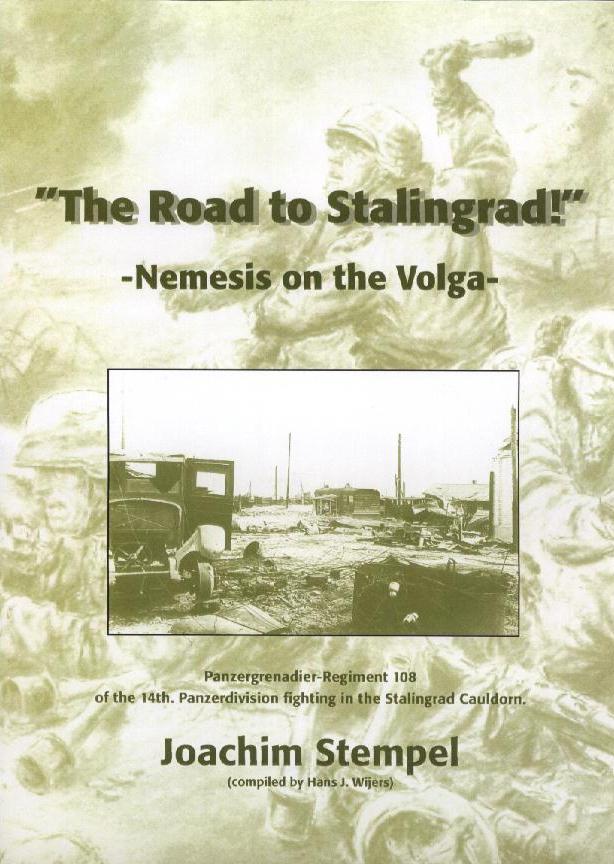|
"The
road to Stalingrad"
Nemesis
on the Volga
The
personal diary of Lt. Joachim Stempel
Son
of Generalleutnant Richard Stempel who was
killed
in action at Stalingrad on 26 January 1943.
Compiled
by Hans Wijers
Price
: $ 45.00 (incl. shipment ww)
Type: Text History
Battle/Campaign: Stalingrad
Basics: Soft cover, 8.5"x11", ~170 pages,
photographs, documents
!
Click
here to order ! |

|
|
Excerpt from the book "The Road to Stalingrad - Nemesis on the Volga" by Leutnant u. Zugfhr. Joachim Stempel (Pz.GrenRgt. 108 i.d. 14.Panzerdivision).
"24 October 1942. Attacks to take possession of the Administration building of the Bread Factory"
'And then it is time. In front of us is the administration building of the 'Bread factory'. And here they come - our Stuka's (dive bombers)! We're attacking! Meter by meter we crawl forward, following the bombs that the Stuka's are dropping in front of us. The howling of sirens, explosions, breaking, splitting, fountains of mud by the exploding bombs! Gun- salvoes from the machines that are pulling up, that partially impact near us - around us - with their nauseating explosions force us to take cover for the time. And then it hows overhead - hopefully not short - our own artillery! But also over from the other side! Whole series of salvoes by the Soviet artillery make the earth shake, with a exploding sound they impact in the factory walls that still are standing over there and spread a noise - like that of an underground train entering a station. Unbelievable, one cannot understand anything anymore. We continue to jump from shell crater to shell crater, from earth pile to the next remains of a wall! Now quickly to the block of house, to the next cover. And once again it comes down on us - the fire of Soviet salvo guns! Onwards! - we have to seize the last hundred metres to the Volga! But the Russians are hanging tough and bitterly contest every hole in the earth and every pile of rubble - and snipers, who with their fire, that hits us in the flank, inflict bloody losses, are lurking everywhere. They are hiding all around, but they cannot be spotted at all........
Description: This account is a continuous narrative written by an
eyewitness, based on his complete diary; a junior officer in a Panzer-Division senselessly sacrificed in the street fighting. His
varied experiences include being put in charge of the last 40 able-bodied men of a Panzergrenadier-Regiment, charged with fighting his
way through to the banks of the Volga, 100 meters away; facing Russian
positions no more than 50 meters away which protected the headquarters
of General Chuikov's 62nd Army and finally reaching the Volga bank, with
the enemy as close as 30 meters, fired on from all sides, in a narrow
salient - and at the other extreme being given 'freedom of action' by
his regimental commander. Characteristically he chose to break out
rather than surrender. On that same day, in a particularly poignant
passage, he took his last leave of his father, Generalleutnant Richard
Stempel, commander of the neighboring 371. Infanterie-Division: neither
could face with equanimity the prospect of Soviet captivity (wisely, in view of the outcome: of 93,000 taken
prisoner, only 6,000 would see Germany again), each chose his
own alternative to surrender. What is most remarkable in Stempel's
diaries and letters home is the faith in higher authorities - Paulus,
von Manstein but above all the Fuhrer, Adolf Hitler - which explains why
the Sixth Army held out for so long. Hopeless in hindsight, the
resistance appeared perfectly logical at the time: the Sixth Army had
been invincible to date; it had had its crises but had always surmounted
them. Besieged German formations had held out successfully during the
winter of 1941-42 and beyond (at Kholm and Dyemyansk), the Luftwaffe had
never let the Army down and the Fuhrer had promised he would get them
out. The Luftwaffe did indeed do its utmost, as did the Panzer units of
Hoth's relief force; but to no avail. The most awful moments in this volume are those which capture the despair of the doomed
garrison which nevertheless did its duty, aware that by holding out for
as long as their strength lasted they would save the rest of the eastern
army, winning time for a new front to be built in the west. In time, a
'new' 14 Panzer-Division and a 'new' Sixth Army would be established.
Of the 'old', there only remained the mass graves in the steppe, the
emaciated survivors in the work camps of the Soviet interior and an
imperishable.
|